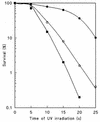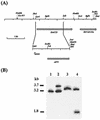The spoilage yeast Zygosaccharomyces bailii forms mitotic spores: a screening method for haploidization
- PMID: 12514054
- PMCID: PMC152455
- DOI: 10.1128/AEM.69.1.649-653.2003
The spoilage yeast Zygosaccharomyces bailii forms mitotic spores: a screening method for haploidization
Abstract
Zygosaccharomyces bailii ISA 1307 and the type strain of this spoilage yeast show a diploid DNA content. Together with a rather peculiar life cycle in which mitotic but no meiotic spores appear to be formed, the diploid DNA content explains the observed difficulties in obtaining auxotrophic mutants. Mitotic chromosome loss induced by benomyl and selection on canavanine media resulted in three haploid strains of Z. bailii. This new set of Z. bailii strains allows the easy isolation of recessive mutants and is suitable for further molecular genetic studies.
Figures




Similar articles
-
Genome sequence of the highly weak-acid-tolerant Zygosaccharomyces bailii IST302, amenable to genetic manipulations and physiological studies.FEMS Yeast Res. 2017 Jun 1;17(4):fox025. doi: 10.1093/femsyr/fox025. FEMS Yeast Res. 2017. PMID: 28460089 Free PMC article.
-
Investigating the multibudded and binucleate phenotype of the yeast Zygosaccharomyces bailii growing on minimal medium.FEMS Yeast Res. 2008 Sep;8(6):906-15. doi: 10.1111/j.1567-1364.2008.00417.x. Epub 2008 Jul 24. FEMS Yeast Res. 2008. PMID: 18662320
-
Targeted gene deletion in Zygosaccharomyces bailii.Yeast. 2001 Jan 30;18(2):173-86. doi: 10.1002/1097-0061(20010130)18:2<173::AID-YEA663>3.0.CO;2-F. Yeast. 2001. PMID: 11169759
-
Sour rot-damaged grapes are sources of wine spoilage yeasts.FEMS Yeast Res. 2008 Nov;8(7):1008-17. doi: 10.1111/j.1567-1364.2008.00399.x. Epub 2008 Jun 12. FEMS Yeast Res. 2008. PMID: 18554306 Review.
-
The spoilage yeast Zygosaccharomyces bailii: Foe or friend?Yeast. 2017 Sep;34(9):359-370. doi: 10.1002/yea.3238. Epub 2017 Jun 29. Yeast. 2017. PMID: 28556381 Review.
Cited by
-
Eukaryote-to-eukaryote gene transfer events revealed by the genome sequence of the wine yeast Saccharomyces cerevisiae EC1118.Proc Natl Acad Sci U S A. 2009 Sep 22;106(38):16333-8. doi: 10.1073/pnas.0904673106. Epub 2009 Sep 9. Proc Natl Acad Sci U S A. 2009. PMID: 19805302 Free PMC article.
-
Ploidy Determination in the Pathogenic Fungus Sporothrix spp.Front Microbiol. 2019 Feb 25;10:284. doi: 10.3389/fmicb.2019.00284. eCollection 2019. Front Microbiol. 2019. PMID: 30858833 Free PMC article.
-
Evolutionary restoration of fertility in an interspecies hybrid yeast, by whole-genome duplication after a failed mating-type switch.PLoS Biol. 2017 May 16;15(5):e2002128. doi: 10.1371/journal.pbio.2002128. eCollection 2017 May. PLoS Biol. 2017. PMID: 28510588 Free PMC article.
-
Population polymorphism of nuclear mitochondrial DNA insertions reveals widespread diploidy associated with loss of heterozygosity in Debaryomyces hansenii.Eukaryot Cell. 2010 Mar;9(3):449-59. doi: 10.1128/EC.00263-09. Epub 2010 Jan 4. Eukaryot Cell. 2010. PMID: 20048048 Free PMC article.
-
Glycolytic Functions Are Conserved in the Genome of the Wine Yeast Hanseniaspora uvarum, and Pyruvate Kinase Limits Its Capacity for Alcoholic Fermentation.Appl Environ Microbiol. 2017 Oct 31;83(22):e01580-17. doi: 10.1128/AEM.01580-17. Print 2017 Nov 15. Appl Environ Microbiol. 2017. PMID: 28887422 Free PMC article.
References
-
- Ahmad, M., and H. Bussey. 1986. Yeast arginine permease: nucleotide sequence of the CAN1 gene. Curr. Genet. 10:587-592. - PubMed
-
- Barnett, J. A. 1992. The taxonomy of the genus Saccharomyces Meyen ex Reess: a short review for non-taxonomists. Yeast 8:1-23. - PubMed
-
- Barnett, J. A., R. W. Payne, and D. Yarrow. 1990. Yeasts: characteristics and identification. University Press, Cambridge, United Kingdom.
-
- Boeke, J. D., J. Trueheart, G. Natsoulis, and G. R. Fink. 1987. 5-Fluoroorotic acid as a selective agent in yeast molecular genetics. Methods Enzymol. 154:164-175. - PubMed
-
- Bullock, W. O., J. M. Fernandez, and J. M. S. Short. 1987. XL#1-Blue: a highly efficient plasmid transforming recA Escherichia coli strain with β-galactosidase selection. BioTechniques 4:376-378.
Publication types
MeSH terms
Substances
LinkOut - more resources
Full Text Sources

